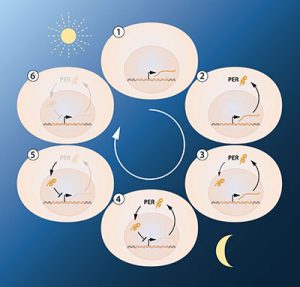Oct 03 2017
Nobel in Medicine for Circadian Rhythm
 Remember that time Sarah Palin said:
Remember that time Sarah Palin said:
“[tax] dollars go to projects that have little or nothing to do with the public good — things like fruit fly research in Paris, France. I kid you not.”
OK, she was actually referring to the olive fruit fly, Bactrocera oleae, not the staple of genetics research, Drosophila melanogaster. The comment is still a legitimate target for criticism because it is not clear that Palin understands the difference (or she wouldn’t have said it that way), her statement seems to imply that scientific research into the humble “fruit fly” is a waste, and she is generally anti-science (when it conflicts with her ideology).
At the time of her statement many scientists and reporters delighted in pointing out how central fruit fly research has been to scientific advancements. Well, we can add another example from this year’s Nobel Prize in Physiology or Medicine. The prize goes to three American scientists, Jeffrey C. Hall, Michael Rosbash and Michael W. Young, for their work on the circadian rhythm.
The Body Clock
The circadian rhythm (which many outlets are calling the “body clock” to avoid jargon) is an internal biological clock shared by all multi-cellular creatures. We have actually known for a long time that multi-cellular life has such an internal clock. As the Nobel press release points out:
During the 18th century, the astronomer Jean Jacques d’Ortous de Mairan studied mimosa plants, and found that the leaves opened towards the sun during daytime and closed at dusk. He wondered what would happen if the plant was placed in constant darkness. He found that independent of daily sunlight the leaves continued to follow their normal daily oscillation. Plants seemed to have their own biological clock.
The mimosa followed a 24 hour cycle even without the external clues of light and dark. It then took almost three centuries to figure out the mechanism for this internal clock.
In the 1970s Seymour Benzer and Ronald Konopka identified a gene in fruit flies (thank you) they called the period gene. Mutations in this gene disrupted the circadian rhythm in fruit flies.
This brings us to the work of the three Nobel winners – they isolated the period gene and characterized its protein product, which they called PER. The PER protein, they found, increases while we are sleeping at night and then decreases throughout the day. So now we have a gene that is clearly important to the circadian rhythm, and the levels of its protein are tied to the 24 hour cycle. The next question is – how are the levels of this protein regulated?
They discovered that the PER protein inhibits its own synthesis. This means that the protein will build up until it turns off its own synthesis, and then levels will drop as the protein degrades until it is low enough that synthesis is turned back on, and the protein builds up again. This self-inhibitory feedback loop is all that is necessary to create this endless cycle.
But more questions remained. How does the PER protein inhibit its own synthesis? At the very least it would have to gain access to the cell’s nucleus where the DNA lives. Young discovered a gene called the timeless gene which makes a protein called TIM. The TIM protein binds to the PER protein, and together they make Voltron – I mean together they are able to be transported into the nucleus where they inhibit the period gene.
Young then discovered another gene he called doubletime which makes the DBT protein. This protein delays the accumulation of the PER protein, so it can be used to tweak the duration of this cycle.
There’s more – the laureates and other researchers identified other genes which regulate this system, including responding to light levels so that the protein cycle synchronizes with the day.
This day-long clock apparently exists in every cell in every multi-cellular creature. This implies that it is evolutionarily very ancient, and is fundamental to cellular function. Once cells developed a clock, a host of other cellular functions, and by extension physiological functions, could be tied to it. Obviously there is the sleep-wake cycle, but there are also daily variations in blood pressure, cortisol levels, body temperature, and alertness.
This research and these researchers were recognized by the Nobel committee because of how central their work is to understanding biology, and how many potential implications it has. The circadian rhythm of cells is a basic cellular function that potentially drives many other functions.






